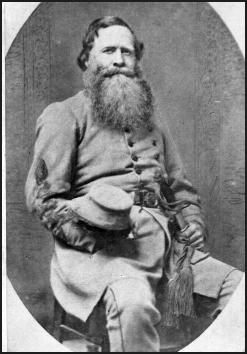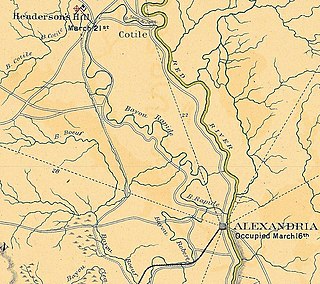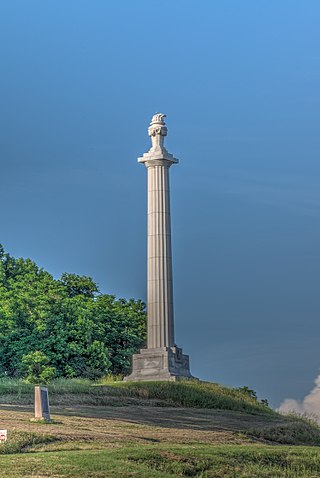
The Battle of Mansfield, also known as the Battle of Sabine Crossroads, on April 8, 1864, in Louisiana formed part of the Red River Campaign during the American Civil War, when Union forces were attempting to occupy the Louisiana state capital, Shreveport.

Richard "Dick" Taylor was an American planter, politician, military historian, and Confederate general. Following the outbreak of the American Civil War, Taylor joined the Confederate States Army, serving first as a brigade commander in Virginia and later as an army commander in the Trans-Mississippi Theater. Taylor commanded the District of West Louisiana and opposed United States troops advancing through upper northwest Louisiana during the Red River Campaign of 1864. He was the only son of Zachary Taylor, the 12th president of the United States. After the war and Reconstruction, Taylor published a memoir about his experiences.

Jean-Jacques-Alfred-Alexandre "Alfred" Mouton was a Confederate general in the American Civil War. Although trained at West Point, he soon resigned his commission to become a civil engineer and then a sugarcane grower, while also serving as a brigadier general in the Louisiana State Militia.
The Battle of Fort Bisland was fought in the American Civil War between Union Major General Nathaniel P. Banks against Confederate Major General Richard Taylor during Banks' operations against the Bayou Teche region in southern Louisiana.

The Battle of Irish Bend, also known as Nerson's Woods or Franklin, took place during the American Civil War. It was fought between Union Major General Nathaniel Prentice Banks against Confederate Major General Richard Taylor during Banks's operations against the Bayou Teche region near Franklin, the seat of St. Mary Parish in southern Louisiana.

Arthur Pendleton Bagby Jr. was an American lawyer, editor, and Confederate States Army colonel during the American Civil War. Confederate General E. Kirby Smith, commander of the Trans-Mississippi Department assigned Bagby to duty as a brigadier general on April 13, 1864, to date from March 17, 1864, and as a major general on May 16, 1865. These extra-legal appointments were not made official by appointments of Bagby to general officer grade by Confederate President Jefferson Davis or by confirmation by the Confederate Senate.

The Battle of Blair's Landing saw a Confederate cavalry-artillery force commanded by Brigadier General Tom Green attack several Union gunboats led by Rear Admiral David Dixon Porter and soldiers in river transports under Brigadier General Thomas Kilby Smith in Red River Parish, Louisiana. Green's force attempted but failed to stop the retreat of Porter's and Smith's forces downstream in an action that was part of the Red River Campaign of the American Civil War. The only significant casualty during the fighting was Green, who was killed by an artillery round.
The Battle of Yellow Bayou, also known as the Battle of Norwood's Plantation, saw Union Army forces led by Brigadier General Joseph A. Mower clash with Confederate States Army troops commanded by Brigadier General John A. Wharton in Avoyelles Parish, Louisiana during the American Civil War. This was the final action of the Red River campaign in which a Union army under Major General Nathaniel P. Banks was repulsed by Confederate forces led by Major General Richard Taylor. The failed Union campaign almost ended in disaster when an accompanying Union fleet led by Rear Admiral David Dixon Porter was trapped at Alexandria, Louisiana, by low water in the Red River. An engineering feat saved the fleet, allowing Banks' army to complete its withdrawal.

Henry Gray, Jr. was an American lawyer and politician who served in the state legislatures of Mississippi and then Louisiana. During the American Civil War, he was a general in the Confederate Army and subsequently served in the Confederate States Congress.

The 18th Texas Infantry Regiment was a unit of volunteers recruited in Texas that fought in the Confederate States Army during the American Civil War. The regiment was enrolled in Confederate service in May 1862 and always campaigned west of the Mississippi River in the region known as the Trans-Mississippi Department. The unit was assigned to the Texas infantry division known as Walker's Greyhounds. The regiment fought at Milliken's Bend, Richmond (La.), and Bayou Bourbeux in 1863 and Mansfield, Pleasant Hill, and Jenkins' Ferry in 1864. The regiment disbanded in mid-May 1865, but its formal surrender date was 26 May 1865.

The 11th Texas Infantry Regiment was a unit of volunteers recruited in Texas that fought in the Confederate States Army during the American Civil War. The regiment organized in the winter of 1861–1862 and always served west of the Mississippi River in the Trans-Mississippi Department. The unit was assigned to the 2nd Brigade of the Texas infantry division known as Walker's Greyhounds. The regiment fought at Milliken's Bend and Bayou Bourbeux in 1863 and Mansfield, Pleasant Hill, and Jenkins' Ferry in 1864. The regiment disbanded in mid-May 1865, but its formal surrender date was 26 May 1865.

The Battle of Henderson's Hill, also known as the Bayou Rapides, saw a reinforced Union Army division led by Brigadier General Joseph A. Mower opposed by a regiment of Confederate Army cavalry and attached artillery under Colonel William G. Vincent. That evening, during a rainstorm, Mower sent one infantry brigade on a circuitous march to gain the rear of Vincent's command. The brigade's subsequent attack surprised and captured most of the Confederates. Mower could not exploit his minor victory because the arrival of additional Federal army and naval units was delayed. This clash occurred during the Red River campaign of the American Civil War which saw Major General Nathaniel P. Banks' Union army try to seize Shreveport, Louisiana, from its Confederate defenders led by Lieutenant General Richard Taylor.

The 28th Texas Cavalry Regiment was a unit of mounted volunteers recruited in east Texas that fought in the Confederate States Army during the American Civil War. In May 1862, the regiment entered Confederate service and served the entire war west of the Mississippi River in the region known as the Trans-Mississippi Department. The unit was soon dismounted before being assigned to the 2nd Brigade of the all-Texas infantry division known as Walker's Greyhounds. In 1863, the regiment played a secondary role at Milliken's Bend. The regiment fought in three major battles during April 1864, at Mansfield, Pleasant Hill, and Jenkins' Ferry. The Trans-Mississippi Department surrendered on 26 May 1865, but the survivors dispersed to their homes before that date.

The 2nd Louisiana Cavalry Regiment was a unit of mounted volunteers recruited in Louisiana that fought in the Confederate States Army during the American Civil War. Breazeale's Cavalry Battalion was formed in July 1862 and was augmented by five additional companies in September 1862 to form a regiment. It served for the entire war west of the Mississippi River in the Trans-Mississippi Department. The regiment fought at Georgia Landing, Fort Bisland, Irish Bend, and Brashear City in 1863 and Henderson's Hill and Mansfield in 1864. Afterward, the regiment fought in minor skirmishes before the Trans-Mississippi's final surrender on 26 May 1865.

The 6th Louisiana Infantry Regiment served in the Confederate States Army during the American Civil War. It was part of the Louisiana Tigers. Formed in June 1861 at Camp Moore, it fought in Jackson's Valley campaign, the Battle of Gaines Mill, the Second Battle of Bull Run and its related actions, and the Battle of Antietam in 1862. The next year, it fought at the Second Battle of Fredericksburg, the Battle of Salem Church, the Second Battle of Winchester, and the Battle of Gettysburg before being overrun at the Second Battle of Rappahannock Station. It spent 1864 fighting in Grant's Overland campaign and with Jubal Early in the Valley campaigns of 1864. The regiment fought in the Battle of Hatcher's Run and the Battle of Fort Stedman in early 1865 before surrendering after the Battle of Appomattox Court House in April. It began its service with 916 men and ended with 52.

The 18th Louisiana Infantry Regiment was a unit of volunteers recruited in Louisiana that fought in the Confederate States Army during the American Civil War. The regiment began forming in October 1861, but did not reach its full complement of 10 companies until January 1862. It served throughout the war in the Western Theater of the American Civil War. In 1862, the regiment served at Shiloh, First Corinth and Georgia Landing (Labadieville). In 1863, it fought at Fort Bisland and campaigned in south Louisiana. In November 1863, the unit merged with the 10th Louisiana Infantry Battalion, creating the 18th Consolidated Louisiana Infantry Regiment. The new regiment served during the Red River campaign in 1864, fighting at Mansfield, Pleasant Hill, and Yellow Bayou. The regiment remained in Louisiana and Arkansas for the rest of the war, before disbanding in May 1865.

The 31st Louisiana Infantry Regiment was a unit of volunteers recruited in Louisiana that fought in the Confederate States Army during the American Civil War. The unit began its existence as Morrison's Battalion on 14 May 1862. The regiment organized at Monroe, Louisiana, on 11 June, after which it moved to Madison Parish, Louisiana, near Vicksburg, Mississippi. The unit stayed near Tallulah and Delhi until November, when it was ordered to Jackson, Mississippi. There, the Catahoula Battalion joined the regiment, bringing it up to ten companies. In December 1862, the regiment fought at Chickasaw Bayou. After remaining near Vicksburg in the early part of the year, it fought at Port Gibson on 1 May 1863. During the Siege of Vicksburg, the soldiers defended the city, surrendered when the place fell, and were paroled. When the regiment was exchanged in June 1864, many of the men chose to remain at home. The soldiers who returned to duty eventually marched to Pineville, which they guarded until February 1865. At that time, the regiment marched to Bayou Cotile. The unit disbanded in May 1865.

The 24th Louisiana Infantry Regiment was a unit of volunteers recruited in Louisiana that fought in the Confederate States Army during the American Civil War. The Crescent Regiment, a state militia unit, transferred to Confederate service at New Orleans in March 1862 for a 90-day enlistment. The regiment immediately traveled to join the Confederaste army at Corinth, Mississippi, and fought at Shiloh and First Corinth. The regiment disbanded in June at the end of its term of service, most of the men joining the 18th Louisiana Infantry Regiment. The regiment was revived at New Iberia, Louisiana, in September 1862, where it was rejoined by the men in the 18th Louisiana. It fought at Georgia Landing (Labadieville) in October 1862 and at Fort Bisland in April 1863. In November 1863 at Simmesport, the regiment merged with the 11th and 12th Louisiana Infantry Battalions, becoming the Consolidated Crescent Regiment. The new regiment fought at Mansfield, Pleasant Hill, and Yellow Bayou in April and May 1864. At Mansfield, all three field officers were fatalities and 175 soldiers became casualties. The regiment spent the rest of the war in Arkansas and Louisiana before disbanding in May 1865.

The 1st Louisiana Field Battery was an artillery unit recruited from volunteers in Louisiana that fought in the Confederate States Army during the American Civil War. The battery mustered into Confederate service in October 1861. The unit traveled to Fort Jackson in early 1862 and took part in the defense of Forts Jackson and St. Philip. The soldiers became prisoners when the forts surrendered and the battery reformed at Franklin after their prisoner exchange. The battery fought at Fort Bisland and Irish Bend in 1863. Later in the year the battery engaged Union shipping on the rivers in several actions. In 1864 the battery briefly fought at Mansfield before its commander was killed while engaging Union gunboats in late April. The unit also fought at Mansura and Yellow Bayou. The battery was in Texas when the Trans-Mississippi Department surrendered in May 1865.
The 5th Louisiana Field Battery was an artillery unit recruited from volunteers in Louisiana that fought in the Confederate States Army during the American Civil War. The Pelican Artillery organized on 31 October 1862, recruiting men mostly from St. James Parish, Louisiana. The battery first saw action in November 1862 against Union gunboats on Bayou Teche. In April 1863, the unit distinguished itself at Fort Bisland and it fought a skirmish at Vermilion Bayou a few days later. In July 1863, the battery fired on Federal shipping at Gaudet's Plantation near Donaldsonville, Louisiana, and fought at Kock's Plantation. In April 1864, it served during the Red River campaign and was present, but not engaged at the battles of Mansfield and Pleasant Hill. In May 1864, the unit was engaged at Mansura and Yellow Bayou. The battery surrendered in early June 1865 while at Tyler, Texas. A total of 183 men enlisted in the battery during the war; 2 were killed in action, 5 died from disease, and 1 drowned.















